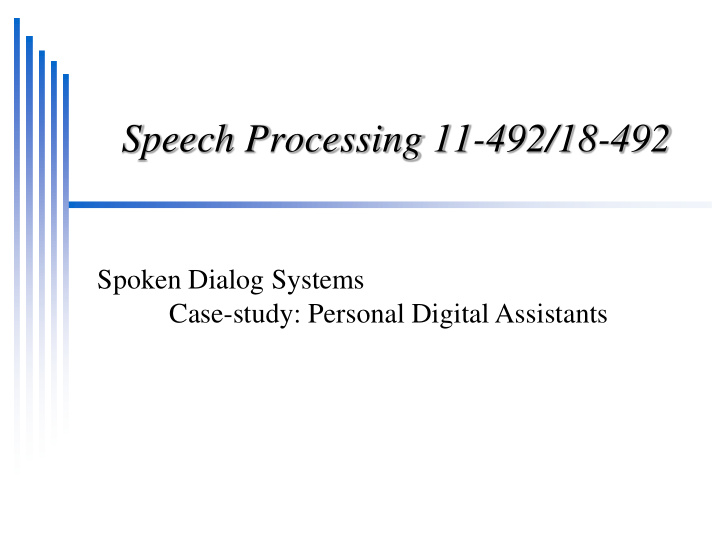



Speech Processing 11-492/18-492 Spoken Dialog Systems Case-study: Personal Digital Assistants
Speech-based Personal Digital Assistant Build a speech enabled PDA Speech in/out for individual use Goals Control schedule Control messaging Replace personal assistant Any similarity to any existing product is purely coincidental Disclaimer: Much of this is relevant to Apple’s Siri, but this information is general and may or may not be what is in Siri.
SPDA:Scope Schedule Calls (in and out?) Navigation Finding local businesses With reviews Open questions Reminders/Alarms
SPDA: Scope “Call John” “Call John, Bill and Mary and setup a meeting sometime next week about Plan B that’s fits my schedule” “Make a reservation at a local Chinese restaurant for 4 at 8pm.” “You should call your mom as its her birthday” “I have sent flowers to your mom as its her birthday”
CALO (DARPA) Cognitive Assistant that Learns Online DARPA project (2003-2008) Led by SRI (involved many sites, including CMU) Personal Assistant that Learns (Pal) Answers questions Learn from experience Take initiative Spin-off company -> SIRI Aquired by Apple in April 2010
SPDA: Platform Desktop Computational power Phone (non-smartphone) General Magic Was handheld, became phone based Led into GM’s OnStar Smartphone Local to device With Cloud
Smartphone + Cloud Smartphone Know about user Contacts, Schedule etc Same speaker Some computation possible on device Cloud Learn from multiple examples Retrain acoustic/language/understanding models
Voice Search and User Feedback Voice Search Google, Bing, Vlingo, Apple Get users to help label the data Listen to user Show best options They select which on is correct Find out how users actually speak Full sentences vs “search terms” How do English speakers say ethnic names
Voice Search: Simplifications Too many words … Context Where you are (location: home/not home) What is on your phone (contacts) What you’ve said before
Personality Have a character Calls you by name (you choose) Pushy, helpful, nagging … Allow user choice Personalize it May form better relationship with it e.g. Siri US and UK are female/male
Make it do things well Targeted apps Chose what it will do well Say, 12 different apps Have target (hand written) interaction Chose what fields you need, and how to intereact with the back end data If all else fails dump result in Google Hardware aid Infra-red detector for VAD
Marketing Make sure people know its there (Voice search has been on PDA’s for years) Get a *lot* of people to use it Give “silly” examples People will repeat them, you can adapt your system and expect them to say them
Know Your Users Young educated Standard English speakers (Non-native too?) Can you train them to use it better Get them to adapt
What is Missing? Add an SDK Other app developers will want to allow speech May make it harder to distinguish Dialog context What was said in the previous utterance Others …
Will it work? Will people talk in public Talking on the phone is now acceptable Talking to the phone … Will people continue to use it Cool at first, but easier to use menus Only use for setting alarms Long term use … But others may join in anyway
Recommend
More recommend